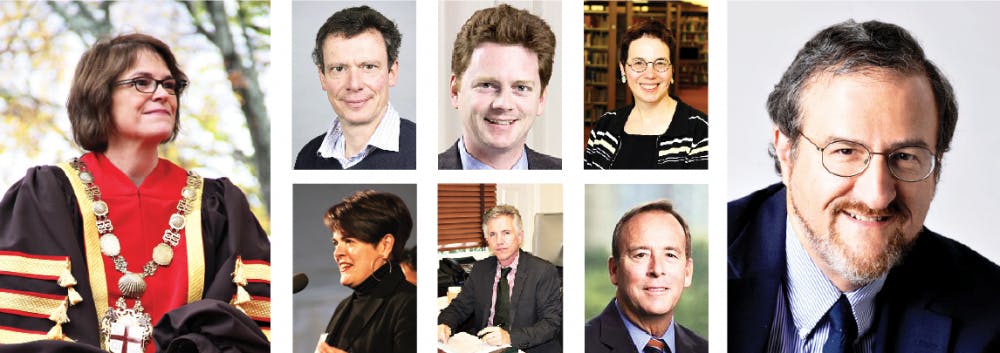The University published interim reports Friday for the six strategic planning committees that are expected to guide President Christina Paxson’s tenure, offering preliminary recommendations and soliciting community involvement in the coming months.
The committees — which concern financial aid, educational innovation, online education, doctoral education, infrastructure and faculty retention, recruitment and development — will submit finalized recommendations to the Corporation in May.
“The hope is over this semester to do more outreach to various constituents, students, faculty and alumni groups,” said Kimberly Roskiewicz, assistant to the president, adding that administrators hope by the end of the semester, “to have more of a focus where we might be heading and how to utilize resources going forward.”
“We presume that a lot of the ideas will evolve, some ideas will drop and some brand new ones will be added to the fodder,” said Provost Mark Schlissel P’15. “Prioritization is very important, a big part of the strategic planning process.”
The committees first presented their findings at a retreat last Tuesday, where all committee members present discussed the broad direction of planning.
“An eight-hour conference the day before school starts is not what one would say is the best way to spend the last day of break, but the conference was actually very fun,” said Patricia Ybarra, co-chair of the Committee on Educational Innovation and associate professor of theater arts and performance studies.
Without committees of their own, the University’s priorities of diversity and internationalization permeated discussion and proposal generation throughout the process. Diversity and internationalization are such crucial considerations that segregating them in specific committees “wouldn’t adequately allow us to pursue these important goals in everything that the University does,” Schlissel said.
“President Paxson and I want to pursue excellence in all that we do, in teaching, in research, in service to the community,” Schlissel said. “We want to make sure Brown remains accessible to students of all backgrounds and financial needs.”
Funding for many of the proposals will come from the University’s existing sources of income, such as tuition, research grants, annual giving from alums and the yield of the University’s endowment. “A lot of the things we’re working on in terms of strategies do not require major capital campaigns,” Schlissel said. “They’re ideas improving how we focus ourselves and how we work.”
The more financially burdensome proposals will be fundamental in the University’s next large capital campaign, the details of which have yet to be determined, Schlissel said. But with the University’s 250th anniversary approaching in 2014, strategic planning may take advantage of the publicity garnered by the sestercentennial celebrations, he said.
Schlissel selected the chairs and members of the committees in September after determining the scope of each committee and consulting various bodies on campus, including deans, department chairs, the Undergraduate Council of Students, the Faculty Executive Committee, the Graduate Student Council and members of the staff. He said he created academically balanced committees to reflect the diversity of the campus and strike the right representative balance.
Many committees build on or modify progress the University made in the Plan for Academic Enrichment — a blueprint for academic initiatives under former President Ruth Simmons. “We’re always evaluating or discarding less attractive ideas,” Schlissel said. The PAE “gives us a framework to make sure everything we’re doing is consistent in where we want to go.”
Just as the PAE guided Simmons’ tenure at the University, Schlissel said the current strategic planning will provide high-level guidance for Paxson’s time at Brown. But unlike in 2002, when the PAE was created, the University is in a great position already, Schlissel said.
In addition to the six committees, the strategic planning process solicited Signature Academic Initiatives, faculty-driven proposals distinguished by interdisciplinary focuses. By December, faculty members had submitted 82 “white papers,” two-page outlines describing how the proposals stood to serve the community, nation and world. The contents of the initiatives range from combating international healthcare disparities to developing human-robot interfaces.
These initiatives follow a different timeline than the proposals of the six committees. The Academic Priorities Committee is still reviewing and assessing the white papers and will identify six themes that will most likely be the results of merging and modifying proposals into heftier research opportunities. Out of these six themes, which will be developed during the summer, the president and provost will select two or three Signature Academic Initiatives and submit them to the Corporation in spring 2014. Some proposals that were not selected but were still compelling will be funded with any available funds, as determined by the provost’s office.

ADVERTISEMENT




